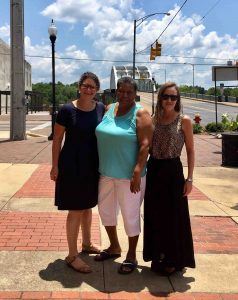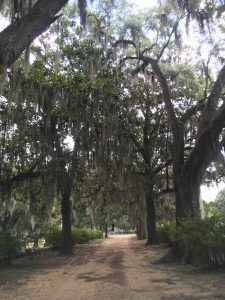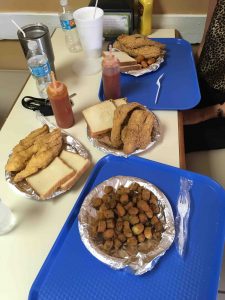This blog post is probably the hardest to write so far. I am filled to the brim with ideas, thoughts, and frustrations. Writing a blog is harder than I thought, for documenting feeling (with the fear of over-sharing), needing to be sensitive and the fear of offending, and realizing that you are putting words down that might stay online for a long time is pressurizing and a commitment. Like any long term relationship, one needs to be considerate, thoughtful and caring at all times. So I continue to try my best and thank you all for hanging in with me.
Kellie and I drove down Highway US-80 from Montgomery to Selma – backwards from the way it was marched in 1965. In some ways it felt more symbolic than I initially considered. The reason for this is because as I travel through the Deep South, and the more conversations I have with all sorts of people, the more I feel that America is reverting back in time, to a time even before the Civil Rights movement – pre 1960s! To a time where segregation was the norm, where racial oppression was swept under the carpet, and where economic depravity wasn’t addressed, as it should be. Always an optimist am I.
We approached the town of Selma driving over the Edmond Pettus Bridge. I was so excited to drive over that bridge. After watching the film Selma several times and recently teaching it to my Year 7 students, I was thoroughly engaged in the romance of the film. I knew it was Hollywood-ised, and I was ready for it to be torn apart by those who lived through the march. Nonetheless I was giddy with excitement.
There are so many moments throughout history whose untold and overlooked stories make them much more fascinating than the versions that are typically taught or talked about in the classroom. The 1965 civil rights march from Selma, Alabama to Montgomery is one of those stories. The issues the 1965 Selma campaign raised are all too familiar today: voting rights, the shooting of an unarmed man by a state trooper, the efficacy of protest, and the role of politicians in movements for social change.
In the run-up to the release of Selma, there also has been a lot of conversation about who exactly was responsible for the political shift and resulting legislation. What role did activists play? What role did the president play? A careful study of this history reveals that a diverse group of constituents—members of the Student Nonviolent Coordinating Committee (SNCC) and the Southern Christian Leadership Conference (SCLC), individuals (white, black, Jewish, Northern, Southern, and many others who pushed for change), and activists including John Lewis, Rev. Dr. Martin Luther King, Jr., and others—all came together to create the conditions that allowed American President Lyndon Baines Johnson to rally popular and political support for the Voting Rights Act of 1965.
What is so often lost in the teaching of the march, and what makes its particular history so compelling, is that it was the collective actions of these groups and individuals, from a variety of backgrounds and philosophies, that together pushed politicians into creating one of the defining pieces of legislation of the 20th century. And one such person was Joanne Bland.
The highlight of the day was spending a good 3 hours talking, walking, driving, and sharing lunch with Joanne Bland. Joanne (born in Selma) is the co-founder and former director of the National Voting Rights Museum in Selma, Alabama. Joanne was a highly active participant in the Civil Rights Movement from her earliest days, and was the youngest person to have been jailed during any civil rights demonstration during that period.
Joanne began her activism in 1961, attending a freedom and voters’ rights meeting presided over by Martin Luther King Jr. She was jailed with her family at the age of 8, and again as a teenager! When I asked her if they sang in prison, she remarked: “Of course! How else are you going to spend the time?” The SNCC members active in Selma organised local teenagers to participate in the movement, including marching on “Bloody Sunday” and “Turn Around Tuesday”. On “Bloody Sunday”, March 7, 1965, Joanne witnessed fellow activists being beaten by the police and Alabama State Troopers. She drove us through Selma, past where she used to live in the George Washington Carver Estates. She drove us to the Brown Chapel AME church where the Selma-Montgomery marches would start from, to the First Baptist Church where the people tried to escape to as the Alabama state troopers chased them on Bloody Sunday.
Hanging out with Joanne was hilarious. Kellie and I giggled at her matter of fact humour. I considered what it would be like to introduce her to Grandma Rayner – the two of them, going at it, telling it how it is. There was no messing about with Joanne, and I was incredibly grateful to her for her passion, her dedication to continue to share her history, and for her time that she spent with us. I shared with her stories about King Alfred School and mostly about the Village Project. She loved it, and I dreamed of her telling her story in the school mphitheatre on a spring evening in the future to a bunch of wide-eyed Year 8s.
Joanne drove us through a plethora of neighborhoods, past her own house, past the mansions with swings on their porches. And she took us to the Old Live Oak Cemetery. The trees were thick with Spanish moss delicately hanging down cloaking the tombstones. The green trees were low, enabling the light to dance. It seemed like a magical place from the entrance. Ever so slowly, as the car crept through the cemetery, I spotted a red flag with a cross in the distance. I turned to Joanne and incredulously said: “Isn’t that a Confederate flag?” She ironically retorted: “Oh now, is it?” The car stopped and we got out. The cemetery was covered in small Confederate flags, just as an English field is covered in buttercups – just not at all with the same sentiment. It was confronting and difficult to stomach. What was the most horrific of all was the pristinely kept bust of Nathan Bedford Forrest who was the lieutenant general for the Confederacy during the Civil War and the memorial refers to him as “Defender of Selma” and “Wizard of the Saddle.” Forrest also served as the Grand Wizard of the Ku Klux Klan. African- American Selma residents protested and called for the bust to be removed – but there it was. The three of us sat in the car for a while – just silent. It was a magnificent disgrace. But for some it remains holy ground. When you google the name of the cemetery and put it into tripadvisor there are so many reviews of people who are so thankful that it stands. What do we do with that?
We were relieved when we left the cemetery, and always with good humour, Joanne tried to convince me to try Catfish at the local BBQ place in the “hood”. We sat together and ate lunch (I ate fried okra and whiting) discussing what the future of education holds. And she said the same exact thing as Bryan Stevenson did. We can’t sugar-coat the teaching of History. We have to tell it how it is so that we can face it, and are able to learn from it. She loves Facing History and is proud of what it has built. And so my confidence grew a little bit.
We left Selma for Birmingham – interested to know how the Jewish community of Birmingham (which I am going to spend time with) has contributed in supporting the local black Alabama community during and after the Civil Rights movement. I know there are many good and wonderfully kind people who do amazing work. Many of you are my dear friends and students. But is this the best we can do? Aren’t we also to blame if we just let it continue to happen all over the world?
So I finished the day with a Bourbon tasting. It lifted the spirits, at least for a while, and was surprisingly smooth and delicious. For many of you who know me at little, you will be surprised that I enjoyed the Bourbon. I definitely slept well.






